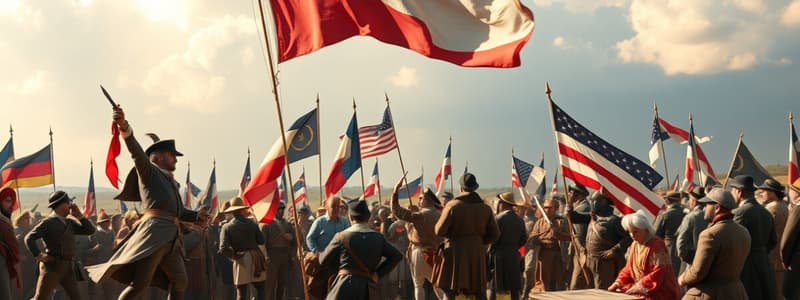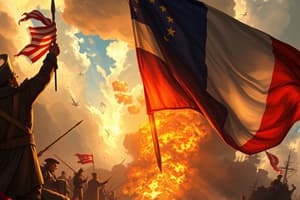Podcast
Questions and Answers
What significant event occurred on July 14, 1789?
What significant event occurred on July 14, 1789?
- The fall of the Bastille (correct)
- The establishment of the National Assembly
- The signing of the Declaration of Independence
- The start of the Reign of Terror
What was the Bastille?
What was the Bastille?
A royal armory and state prison
What date marks the writing of the American Declaration of Independence?
What date marks the writing of the American Declaration of Independence?
July 4, 1776
Natural rights include: life, liberty, and the pursuit of __________.
Natural rights include: life, liberty, and the pursuit of __________.
What location is known for General Cornwallis's surrender?
What location is known for General Cornwallis's surrender?
What are the Bill of Rights?
What are the Bill of Rights?
Who was the Marquis de Lafayette?
Who was the Marquis de Lafayette?
Which statement is true about the First and Second Estates?
Which statement is true about the First and Second Estates?
What was the taille?
What was the taille?
Who made up the Third Estate?
Who made up the Third Estate?
Who wrote the essay 'What is the Third Estate?'
Who wrote the essay 'What is the Third Estate?'
What was the National Assembly?
What was the National Assembly?
The Tennis Court Oath was taken by representatives of the Third Estate to demand ___________.
The Tennis Court Oath was taken by representatives of the Third Estate to demand ___________.
What did the Declaration of the Rights of Man and Citizen represent?
What did the Declaration of the Rights of Man and Citizen represent?
Who was Olympe de Gouges?
Who was Olympe de Gouges?
The Civil Constitution of the Clergy required bishops and priests to be elected and paid by the state.
The Civil Constitution of the Clergy required bishops and priests to be elected and paid by the state.
What was the role of the Jacobins during the French Revolution?
What was the role of the Jacobins during the French Revolution?
What happened during the escape to Varennes?
What happened during the escape to Varennes?
What was the Declaration of Pillnitz?
What was the Declaration of Pillnitz?
What was the Paris Commune?
What was the Paris Commune?
Who were the Sans-Culottes?
Who were the Sans-Culottes?
Who was Georges Danton?
Who was Georges Danton?
What was the main function of the Committee of Public Safety?
What was the main function of the Committee of Public Safety?
What was the Reign of Terror?
What was the Reign of Terror?
What was the main device used for executions during the Reign of Terror?
What was the main device used for executions during the Reign of Terror?
What did the Law of General Maximum aim to do?
What did the Law of General Maximum aim to do?
What was the Temple of Reason?
What was the Temple of Reason?
Who was Toussaint L'Ouverture?
Who was Toussaint L'Ouverture?
What was the Thermidorean Reaction?
What was the Thermidorean Reaction?
What was the Directory?
What was the Directory?
Who was Napoleon Bonaparte?
Who was Napoleon Bonaparte?
What were the Italian and Egyptian Campaigns?
What were the Italian and Egyptian Campaigns?
What is the significance of the Concordat?
What is the significance of the Concordat?
What did the Civil Code establish?
What did the Civil Code establish?
Who was Madame de Stael?
Who was Madame de Stael?
What happened at Austerlitz and Trafalgar?
What happened at Austerlitz and Trafalgar?
Fraternitie translates to _______________ in English.
Fraternitie translates to _______________ in English.
What was the Grand Army?
What was the Grand Army?
What happened to Napoleon after his defeat?
What happened to Napoleon after his defeat?
Study Notes
Key Events and Dates
- July 14, 1789, marked the storming of the Bastille, symbolizing the triumph of liberty over despotism in France.
- July 4, 1776, is the date of the American Declaration of Independence, asserting freedom from Britain, authored primarily by Thomas Jefferson.
Concepts of Rights
- Natural rights include "life, liberty, and the pursuit of happiness."
- The Bill of Rights comprises the first ten amendments to the U.S. Constitution, ratified in March 1789, embodying Enlightenment ideas.
Revolutionary Figures and Groups
- The Marquis de Lafayette returned from America advocating for individual liberties and republicanism.
- Olympe de Gouges challenged gender inequality and demanded equal rights for women in her "Declaration of the Rights of Woman and the Female Citizen" (1791).
Social Classes and Unrest
- The First Estate consisted of clergy, with parish priests being the poorest; the Second Estate comprised nobility, owning significant military and governmental power.
- The Third Estate represented the vast majority of the population, primarily wealthy middle-class professionals who sought greater influence.
Governmental Structures
- French Parlements could block royal edicts, exacerbating France's financial issues.
- The National Assembly emerged when Third Estate members broke away from the Estates-General, leading to significant legislative actions.
Key Revolutionary Actions
- The Tennis Court Oath represented a commitment to proper representation for the Third Estate.
- The Declaration of the Rights of Man and Citizen articulated Enlightenment principles and reflected American influences.
Radical Political Movements
- The Jacobins, a radical political group, played a crucial role in addressing France's crises during the Revolution.
- The Paris Commune called for universal male suffrage to create a democratic constitution.
Military and Political Developments
- The Committee of Public Safety aimed to centralize power and enforce the Reign of Terror, leading to thousands of executions.
- The National Convention abolished the monarchy and established a republic, resulting in internal factional struggles between the Girondins and the Mountain.
Notable Historical Figures
- Maximilien Robespierre, a leading figure in the Mountain, promoted the Reign of Terror and sought to create a "republic of virtue."
- Georges Danton was a critical leader in the early phases of the Revolution, advocating for radical governance.
Aftermath of the Revolution
- The Thermidorean Reaction followed Robespierre's execution, ending the Reign of Terror and ushering in conservative reforms.
- The Directory, characterized by weak leadership, struggled against public discontent and ultimately led to the rise of Napoleon Bonaparte.
Napoleon's Rise and Fall
- Napoleon Bonaparte, a military commander, became Emperor of France and expanded his empire across Europe.
- Major battles included the significant victories in Italy and the disastrous invasion of Russia, leading to the decline of his power.
- After a brief return from exile on Elba, Napoleon was defeated at Waterloo and exiled to Saint Helena.
Studying That Suits You
Use AI to generate personalized quizzes and flashcards to suit your learning preferences.
Description
Explore the key events, concepts of rights, and influential figures that shaped the French and American Revolutions. This quiz covers essential dates such as the storming of the Bastille and the Declaration of Independence, alongside discussions on natural rights and social classes. Test your knowledge of the revolutionary era and its implications on modern concepts of freedom.




